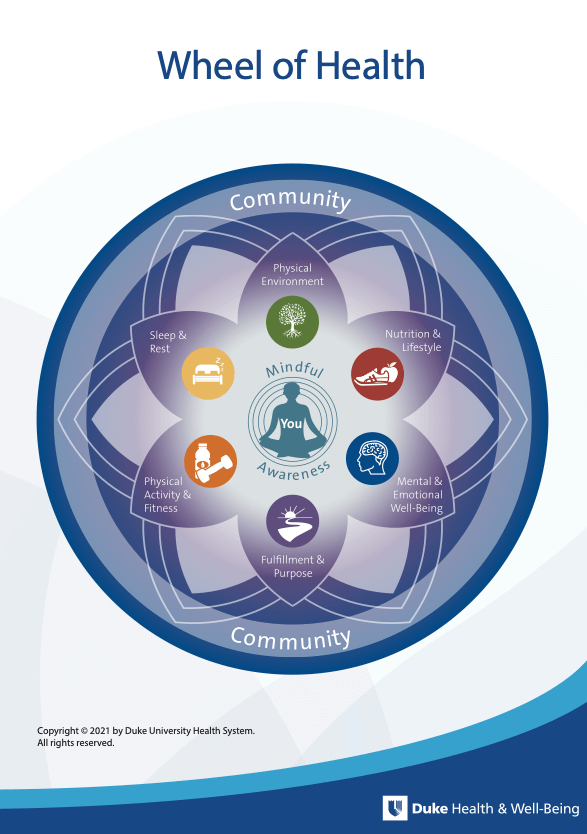8 Dimensions of a Holistic Wellness Wheel of Health
I loved being a personal trainer and group fitness instructor in college but felt limited in those roles. What's the key to helping people accelerate their wellness journey? Physical activity is only one part of the wellness wheel, and eating healthy is easier said than done...
So, what are the other core health values and habits you must prioritize if you want to be wholly well?
Fast forward 20 years, and I now have the perspective and training of a holistic health and wellness coach. This means I walk clients through all aspects of wellness to establish sustainable practices and lifestyle habits.
I use the Duke Wheel of Health from my coach training as an assessment tool for coaching clients. This wellness wheel describes eight facets of a healthy lifestyle. Let's dive into what those are!
Understanding the Wellness Wheel: Why Do You Need It?
When discussing healthy habits, most people think about starting an exercise program and eating a balanced nutritional diet. I agree that solid meal plans and physical activity are vital for a healthy life...but there's more!
A wellness wheel lays out various dimensions of wellness. This visual representation is helpful to show the overall wellness picture. Other components may be affecting your habits, and you didn't even realize it!
When you assess the various dimensions of wellness found in the wheel (something we do in coaching), you can start to map out your wellness journey to achieve optimal health and personal satisfaction with goals that make sense for you individually.
As you might imagine, each area of the wellness wheel is complex. Many factors play into achieving healthy habits and balance. Sometimes, I will work with a coaching client for three months or more on just one piece of the wellness wheel pie.
Duke Health & Well-Being Wheel of Health (WOH)
I completed a Health & Well-Being coach training program through Duke. Their health coaching framework features a wellness wheel with eight components. This is known as the Duke "Wheel of Health". Here is a brief description of each of these areas.
Mindful Awareness
Prioritizing mindful awareness involves being present in the current moment. It includes cultivating mindfulness practices to enhance self-awareness, reduce stress, and promote mental clarity for overall well-being.
Being mindfully aware is the cornerstone to coping effectively with situations you're facing and establishing healthy behaviors. It affects your mind, brain, body, and behavior.
According to Duke, research has shown that mindful awareness can improve and aid:
Mental and physical wellness
Eating and sleeping habits
Substance use/abuse
Spiritual wellness
Relationships and social wellness
Emotional well-being and quality of life
These identified areas are vital for establishing overall quality wellness and healthier habits.
Community
A strong community means fostering meaningful social connections and relationships with others. Supportive social networks have a profound effect on mental health and overall life satisfaction. A high level of social wellness also helps you manage stress.
Strategies to start developing a stronger personal community include:
Establishing various social outlets: finding a social group that supports your wellness habits or likes to spend time doing physical activities is significant for successful habit change.
Developing at least 1-2 close friendships: these trusted relationships can provide needed support.
Nurturing supportive and satisfying relationships: set boundaries and limits in unhealthy relationships full of conflict or toxicity; invest in positive relationships that promote your well-being and are mutually beneficial.
Relationships take time, investment, generosity, and good communication. Your relationships may shift over time and in different seasons of life, so continue to invest in this area.
Physical Environment
Your personal environment dramatically influences your well-being—possibly more than you realize! As a baseline, you want to create and maintain physical spaces that promote health and safety. This includes being free from
allergens
toxins
pests
contaminants
pollution (air, noise, etc.)
Furthermore, ideal environmental wellness means having spaces at work and home that are
well-maintained
organized
clutter-free
engaging to the senses
Stimulating environments strike the right balance between inspiring creativity and promoting calm.
Your environmental wellness and physical environment are also tied to your schedule and routines. When your environment is in order and set up for convenience and efficiency, you have the mental space and clarity to focus on developing healthy habits.
Nutrition and Lifestyle
Recognizing the interconnectedness of nutrition and lifestyle choices encourages individuals to make informed decisions and maintain a healthy diet. We all experience information overload when it comes to diet advice. Still, having a diet action plan with realistic steps for eating healthy is crucial.
Here are some of Duke's basic guidelines for good nutrition:
Aim for 3-5 servings of vegetables and two servings of fruit in various bright colors
Increase healthy monounsaturated and polyunsaturated fats and decrease unhealthy fats and seed oils
Consume at least three servings of protein-rich foods daily
Replace processed foods with fiber-rich foods, including fresh vegetables, whole grains, beans and legumes
Consume a one-ounce serving of nuts and/or seeds most days of the week
Include probiotic-rich foods with live cultures to support a healthy gut microbiome
Drink a minimum of 6 cups of water per day and drink alcohol in moderation
One example of a nutrition-focused and balanced healthy eating plan is the Mediterranean diet. Learn more about the Mediterranean diet.
Mental & Emotional Well-Being
Prioritizing mental and emotional well-being involves understanding and managing one's emotions effectively and nurturing positive mental health. This might mean contacting mental health services for counseling and additional support during difficult situations.
Acknowledging your own feelings and taking time for self-reflection is essential. But you also want to make sure you have proper professional support to find a balance of healthy introspection and being able to move forward.
Mental health and emotional well-being also empower you to handle stress properly. We all have stress, but how we react to stress and manage racing thoughts can make a huge difference in our personal satisfaction.
Some strategies and exercises for managing stress and improving mental health include:
Conscious breathing
Journaling
Meditation
Body Scans (progressive relaxation)
Exercise
Counseling
Fulfillment & Purpose
Having a sense of fulfillment and purpose adds meaning to your life. This category may include occupational wellness, but your greater sense of impact and life purpose can extend beyond your "day job" in many cases. For many people, their spiritual life provides a source of meaning.
Lifelong learning and goal setting can challenge you to expand knowledge, pursue your passions, and make a difference in the world. Your creative abilities, hobbies, and volunteer work may be pathways for fulfillment and purpose in your life.
If you don't have a sense of purpose or feel overwhelmed by work, consider the following steps:
Invest in personal development
Dedicate time to professional development to enhance your career and give you more options
Balance personal life and career: avoid overworking and make time for other things that bring you joy
Consider how spiritual wellness can be a source of comfort and strength in your life
Physical Activity and Fitness
Physical activity is about moving your body; it's more than just exercise! Physical fitness is the outcome of exercise. Exercise provides a vast number of physical health and mental health benefits and can reduce disease.
When planning your physical fitness action plan, be sure to include:
Cardiorespiratory endurance exercises
Muscular strength-building exercises
Flexibility and mobility exercises
Sleep & Rest
A good night's sleep, adequate rest, and restorative relaxation are all part of this segment of the wellness wheel. In the extreme, sleep deprivation and sleep disorders can negatively impact your health and lead to chronic illnesses.
From a positive standpoint, quality sleep and rest will help your body and brain heal, repair, and function optimally. Although sleep needs vary, the standard recommendation for adults is 7-9 hours a night.
Other Wellness Wheel Categories
You may have seen other wellness wheel diagrams and frameworks out there. Many contain similar components but are organized and labeled differently. Some might provide seven dimensions of wellness or other markers for health.
Here are some examples of other labels in wellness wheels:
Physical Wellness Wheel
Physical wellness refers to maintaining a healthy body through regular exercise, proper nutrition, and adequate rest, ultimately enhancing overall well-being and reducing the risk of chronic illnesses.
Emotional Wellness Wheel
Emotional wellness involves understanding and managing one's emotions effectively, fostering healthy relationships, and coping with stressors to achieve mental balance and resilience in various life situations. Emotional wellness is similar to the "Mental & Emotional Well-Being" category above. Also, it encompasses some aspects of the "Community" component.
Occupational Wellness Wheel
Occupational wellness focuses on finding satisfaction and fulfillment in one's work or chosen activities, creating a harmonious balance between professional responsibilities and personal life to promote a sense of purpose and accomplishment. Similar to the "Fulfillment & Purpose" category above.
Financial Wellness Wheel
Financial wellness encompasses smart money management, budgeting, and planning for the future, ensuring economic stability and reducing stress related to financial concerns, contributing to an overall sense of security.
Intellectual Wellness Wheel
Intellectual wellness involves continuous learning, stimulating mental activities and critical thinking, and fostering a curious and open mind, contributing to personal growth, creative abilities, and a deeper understanding of the world.
Spiritual Wellness Wheel
Spiritual wellness may include religious beliefs, encompassing a sense of purpose, inner peace, and connection to something greater than oneself, promoting a harmonious alignment of values and beliefs for a fulfilling life journey.
Summing Up the Wellness Wheel of Health
Whatever wellness model you choose as a tool, it's important to understand there are multiple dimensions of wellness. When you're struggling in one area, it's likely connected to other parts of your well-being.
Taking care of yourself requires time. But remember that your health is your most powerful asset; it's worth the investment!
Raising our standard of well-being in all areas — from community to environment to mental and emotional health well-being — will elevate our lives, improve our energy, and help us feel more fulfilled.
If you're interested in exploring the Wheel of Health in more detail, book a Discovery Call to hear more about the process of online Health & Wellness Coaching.


